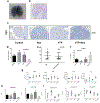Systemic Antitumor Immunity by PD-1/PD-L1 Inhibition Is Potentiated by Vascular-Targeted Photodynamic Therapy of Primary Tumors
- PMID: 28954788
- PMCID: PMC7558370
- DOI: 10.1158/1078-0432.CCR-17-0186
Systemic Antitumor Immunity by PD-1/PD-L1 Inhibition Is Potentiated by Vascular-Targeted Photodynamic Therapy of Primary Tumors
Abstract
Purpose: PD-1/PD-L1 pathway inhibition is effective against advanced renal cell carcinoma, although results are variable and may depend on host factors, including the tumor microenvironment. Vascular-targeted photodynamic (VTP) therapy with the photosensitizer WST11 induces a defined local immune response, and we sought to determine whether this could potentiate the local and systemic antitumor response to PD-1 pathway inhibition.Experimental Design: Using an orthotopic Renca murine model of renal cell carcinoma that develops lung metastases, we treated primary renal tumors with either VTP alone, PD-1/PD-L1 antagonistic antibodies alone, or a combination of VTP and antibodies and then examined treatment responses, including immune infiltration in primary and metastatic sites. Modulation of PD-L1 expression by VTP in human xenograft tumors was also assessed.Results: Treatment of renal tumors with VTP in combination with systemic PD-1/PD-L1 pathway inhibition, but neither treatment alone, resulted in regression of primary tumors, prevented growth of lung metastases, and prolonged survival in a preclinical mouse model. Analysis of tumor-infiltrating lymphocytes revealed that treatment effect was associated with increased CD8+:regulatory T cell (Treg) and CD4+FoxP3-:Treg ratios in primary renal tumors and increased T-cell infiltration in sites of lung metastasis. Furthermore, PD-L1 expression is induced following VTP treatment of human renal cell carcinoma xenografts.Conclusions: Our results demonstrate a role for local immune modulation with VTP in combination with PD-1/PD-L1 pathway inhibition for generation of potent local and systemic antitumor responses. This combined modality strategy may be an effective therapy in cancers resistant to PD-1/PD-L1 pathway inhibition alone. Clin Cancer Res; 24(3); 592-9. ©2017 AACR.
©2017 American Association for Cancer Research.
Figures





References
Publication types
MeSH terms
Substances
Grants and funding
LinkOut - more resources
Full Text Sources
Other Literature Sources
Research Materials

